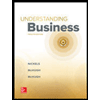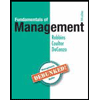Exercise 1.3. Alice (Player 1), Bob (Player 2), and Charlie (Player 3) play the following simultaneous game. They are sitting in different rooms facing a keyboard with only one key and each has to decide whether or not to press the key. Alice wins if the number of people who press the key is odd (that is, all three of them or only Alice or only Bob or only Charlie), Bob wins if exactly two people (he may be one of them) press the key and Charlie wins if nobody presses the key. (a) Represent this situation as a game-frame. Note that we can represent a three- player game with a set of tables. Player 1 chooses the row, Player 2 chooses the column and Player 3 chooses the table (that is, we label the rows with Player 1's strategies, the columns with Player 2's strategies and the tables with Player 3's strategies). (b) Using the game-frame of part (a) obtain a reduced-form game by adding the information that each player prefers winning to not winning and is indifferent between any two outcomes where he/she does not win. For each player use a utility function with values from the set {0,1}. (c) Using the game-frame of part (a) obtain a reduced-form game by adding the information that (1) each player prefers winning to not winning, (2) Alice is indifferent between any two outcomes where she does not win, (3) conditional on not winning, Bob prefers if Charlie wins rather than Alice, (4) conditional on not winning, Charlie prefers if Bob wins rather than Alice. For each player use a utility function with values from the set {0,1,2}. 1.E.2. Exercises for Section 1.2: Strict and weak dominance The answers to the following exercises are in Appendix S at the end of this chapter. Exercise 1.4. There are two players. Each player is given an unmarked envelope and asked to put in it either nothing or $300 of his own money or $600. A referee collects the envelopes, opens them, gathers all the money, then adds 50% of that amount (using his own money) and divides the total into two equal parts which he then distributes to the players. (a) Represent this game frame with two alternative tables: the first table showing in each cell the amount of money distributed to Player 1 and the amount of money distributed to Player 2, the second table showing the change in wealth of each player (money received minus contribution). (b) Suppose that Player 1 has some animosity towards the referee and ranks the outcomes in terms of how much money the referee loses (the more, the better), while Player 2 is selfish and greedy and ranks the outcomes in terms of her own net gain. Represent the corresponding game using a table. (c) Is there a strict dominant-strategy equilibrium?
Exercise 1.3. Alice (Player 1), Bob (Player 2), and Charlie (Player 3) play the following simultaneous game. They are sitting in different rooms facing a keyboard with only one key and each has to decide whether or not to press the key. Alice wins if the number of people who press the key is odd (that is, all three of them or only Alice or only Bob or only Charlie), Bob wins if exactly two people (he may be one of them) press the key and Charlie wins if nobody presses the key. (a) Represent this situation as a game-frame. Note that we can represent a three- player game with a set of tables. Player 1 chooses the row, Player 2 chooses the column and Player 3 chooses the table (that is, we label the rows with Player 1's strategies, the columns with Player 2's strategies and the tables with Player 3's strategies). (b) Using the game-frame of part (a) obtain a reduced-form game by adding the information that each player prefers winning to not winning and is indifferent between any two outcomes where he/she does not win. For each player use a utility function with values from the set {0,1}. (c) Using the game-frame of part (a) obtain a reduced-form game by adding the information that (1) each player prefers winning to not winning, (2) Alice is indifferent between any two outcomes where she does not win, (3) conditional on not winning, Bob prefers if Charlie wins rather than Alice, (4) conditional on not winning, Charlie prefers if Bob wins rather than Alice. For each player use a utility function with values from the set {0,1,2}. 1.E.2. Exercises for Section 1.2: Strict and weak dominance The answers to the following exercises are in Appendix S at the end of this chapter. Exercise 1.4. There are two players. Each player is given an unmarked envelope and asked to put in it either nothing or $300 of his own money or $600. A referee collects the envelopes, opens them, gathers all the money, then adds 50% of that amount (using his own money) and divides the total into two equal parts which he then distributes to the players. (a) Represent this game frame with two alternative tables: the first table showing in each cell the amount of money distributed to Player 1 and the amount of money distributed to Player 2, the second table showing the change in wealth of each player (money received minus contribution). (b) Suppose that Player 1 has some animosity towards the referee and ranks the outcomes in terms of how much money the referee loses (the more, the better), while Player 2 is selfish and greedy and ranks the outcomes in terms of her own net gain. Represent the corresponding game using a table. (c) Is there a strict dominant-strategy equilibrium?
Chapter1: Taking Risks And Making Profits Within The Dynamic Business Environment
Section: Chapter Questions
Problem 1CE
Related questions
Question
Both answer must required with refrences okk

Transcribed Image Text:Exercise 1.3. Alice (Player 1), Bob (Player 2), and Charlie (Player 3) play the
following simultaneous game. They are sitting in different rooms facing a keyboard
with only one key and each has to decide whether or not to press the key. Alice
wins if the number of people who press the key is odd (that is, all three of them or
only Alice or only Bob or only Charlie), Bob wins if exactly two people (he may
be one of them) press the key and Charlie wins if nobody presses the key.
(a) Represent this situation as a game-frame. Note that we can represent a three-
player game with a set of tables. Player 1 chooses the row, Player 2 chooses the
column and Player 3 chooses the table (that is, we label the rows with Player 1's
strategies, the columns with Player 2's strategies and the tables with Player 3's
strategies).
(b) Using the game-frame of part (a) obtain a reduced-form game by adding the
information that each player prefers winning to not winning and is indifferent
between any two outcomes where he/she does not win. For each player use a
utility function with values from the set {0,1}.
(c) Using the game-frame of part (a) obtain a reduced-form game by adding the
information that (1) each player prefers winning to not winning, (2) Alice is
indifferent between any two outcomes where she does not win, (3) conditional
on not winning, Bob prefers if Charlie wins rather than Alice, (4) conditional
on not winning, Charlie prefers if Bob wins rather than Alice. For each player
use a utility function with values from the set {0,1,2}.
1.E.2. Exercises for Section 1.2:
Strict and weak dominance
The answers to the following exercises are in Appendix S at the end of this chapter.
Exercise 1.4. There are two players. Each player is given an unmarked envelope
and asked to put in it either nothing or $300 of his own money or $600. A referee
collects the envelopes, opens them, gathers all the money, then adds 50% of that
amount (using his own money) and divides the total into two equal parts which he
then distributes to the players.
(a) Represent this game frame with two alternative tables: the first table showing in
each cell the amount of money distributed to Player 1 and the amount of
money distributed to Player 2, the second table showing the change in wealth of
each player (money received minus contribution).
(b) Suppose that Player 1 has some animosity towards the referee and ranks the
outcomes in terms of how much money the referee loses (the more, the better),
while Player 2 is selfish and greedy and ranks the outcomes in terms of her own
net gain. Represent the corresponding game using a table.
(c) Is there a strict dominant-strategy equilibrium?
Expert Solution
This question has been solved!
Explore an expertly crafted, step-by-step solution for a thorough understanding of key concepts.
Step by step
Solved in 2 steps with 5 images

Recommended textbooks for you

Understanding Business
Management
ISBN:
9781259929434
Author:
William Nickels
Publisher:
McGraw-Hill Education

Management (14th Edition)
Management
ISBN:
9780134527604
Author:
Stephen P. Robbins, Mary A. Coulter
Publisher:
PEARSON

Spreadsheet Modeling & Decision Analysis: A Pract…
Management
ISBN:
9781305947412
Author:
Cliff Ragsdale
Publisher:
Cengage Learning

Understanding Business
Management
ISBN:
9781259929434
Author:
William Nickels
Publisher:
McGraw-Hill Education

Management (14th Edition)
Management
ISBN:
9780134527604
Author:
Stephen P. Robbins, Mary A. Coulter
Publisher:
PEARSON

Spreadsheet Modeling & Decision Analysis: A Pract…
Management
ISBN:
9781305947412
Author:
Cliff Ragsdale
Publisher:
Cengage Learning

Management Information Systems: Managing The Digi…
Management
ISBN:
9780135191798
Author:
Kenneth C. Laudon, Jane P. Laudon
Publisher:
PEARSON

Business Essentials (12th Edition) (What's New in…
Management
ISBN:
9780134728391
Author:
Ronald J. Ebert, Ricky W. Griffin
Publisher:
PEARSON

Fundamentals of Management (10th Edition)
Management
ISBN:
9780134237473
Author:
Stephen P. Robbins, Mary A. Coulter, David A. De Cenzo
Publisher:
PEARSON